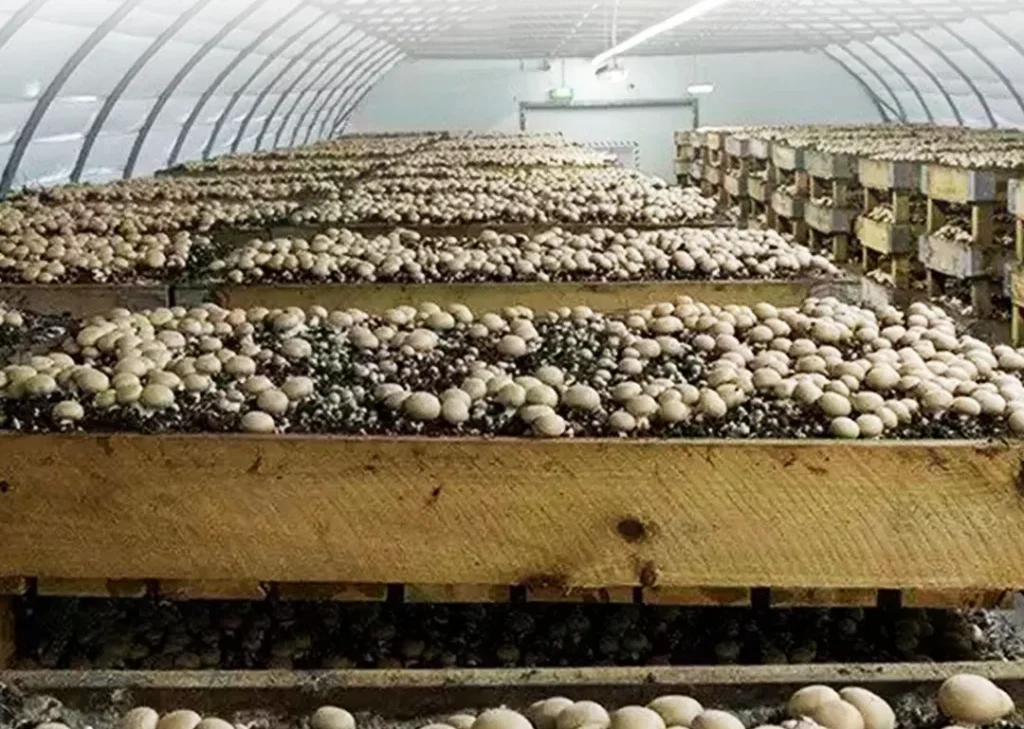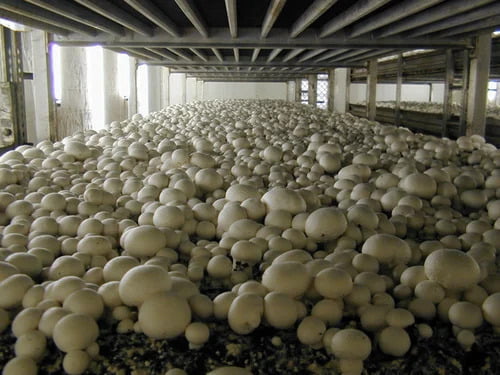Mushroom cultivation can be a lucrative and sustainable business idea, especially in small spaces. The “Jugaad” approach, a popular term in India, refers to a hack, an innovative fix or a simple work-around. In the context of mushroom cultivation, Jugaad can be utilized to create a successful mushroom farming operation, even in small spaces, with limited resources.
Table Of Contents
| S. No. | Contents |
| 1 | Mushroom Cultivation A Cost-Effective Solution |
| 2 | Environmentally Friendly |
| 3 | Low-Cost |
| 4 | Simplified Process |
| 5 | High Yield |
| 6 | Effective in Small Spaces |
| 7 | Adaptable Methods |
| 8 | Labour Intensive |
| 9 | Diversified Income |
| 10 | Source Quality Of Spawn |
| 11 | Prepare An Appropriate Growing Medium |
| 12 | Control Temperature, Humidity, And Light |
| 13 | Monitor And Maintain Contamination Control |
| 14 | Vertical Farming |
| 15 | Upcycling Waste Materials |
| 16 | Community-Supported Agriculture |
| 17 | Growth Opportunities |

Mushroom Cultivation A Cost-Effective Solution
Mushroom cultivation is a profitable and sustainable business idea, especially for small-scale farmers. It is a cost-effective solution for those interested in starting a low-capital agricultural venture
Environmentally Friendly
Sustainable mushroom cultivation methods have a low carbon footprint and require minimal energy and water consumption. These methods are environmentally friendly, making them an attractive option for eco-conscious farmers.
Low-Cost
Mushroom cultivation can be done using locally sourced materials, reducing the overall costs. Using agricultural waste, such as sawdust, straw, and corn cobs, as a substrate for mushroom growth is an effective and affordable method.
Simplified Process
Mushroom cultivation is a simplified process, requiring minimal infrastructure and equipment. Farmers can start the cultivation process indoors, in small spaces, and gradually scale up as their business grows.
High Yield
Mushroom cultivation has a high yield and short growth cycle, making it a profitable venture. A small-scale mushroom farm can produce up to 50-100 kg of mushrooms per month, with a potential profit margin of up to 50%.
Effective in Small Spaces
Mushroom cultivation is effective even in small spaces, making it an attractive option for urban farmers, small-scale farmers, and those with limited resources. With proper planning and management, farmers can produce a significant yield from a small area.
Adaptable Methods
Sustainable mushroom cultivation methods can be adapted to local conditions and resources. Farmers can use locally available materials and equipment, making it an accessible and adaptable business idea.
Labor Intensive
Mushroom cultivation is labor-intensive, providing employment opportunities for rural and urban communities. It is a low-technology industry, requiring minimal skills, and can be easily learned by enthusiasts.
Diversified Income
Mushroom cultivation provides a diversified income stream for small-scale farmers. It can be done as a standalone business or as a complementary activity, providing a source of income during off-seasons.
Source Quality Spawn
Spawn is the mycelium of the mushroom, which is used to inoculate the growing medium. High-quality spawn is essential for successful cultivation.
Prepare An Appropriate Growing Medium
The growing medium is the material on which the mushrooms grow. Common options include straw, sawdust, or compost.
Control Temperature, Humidity, And Light
Mushrooms require specific environmental conditions to grow. Small-scale farmers can use simple tools, such as thermometers, hygrometers, and grow lights, to maintain ideal conditions.
Monitor And Maintain Contamination Control
Mushroom cultivation is susceptible to contamination from other fungi, bacteria, and pests. Implementing good hygiene practices and regular monitoring can help minimize contamination issues. Real-life Examples of Jugaad in Small-scale Mushroom Cultivation.
Vertical Farming
Utilizing vertical space to grow mushrooms, such as stacking shelves or using towers, can increase production in small spaces.

Upcycling Waste Materials
Using discarded materials, such as coffee grounds or agricultural waste, as the growing medium reduces costs and is environmentally friendly.
Community-Supported Agriculture
Building a community of buyers through a subscription model or farmers markets is a cost-effective way to market and sell small-scale mushroom crops.
Growth Opportunities
Successful small-scale mushroom farming can be scaled up over time. Factors to Consider in Small Spaces Mushroom Cultivation
Choose the right mushroom species: Consider factors such as local climate, available resources, and market demand when selecting the mushroom species to cultivate. Oyster, Shiitake, and Button mushrooms are popular choices for small-scale cultivation.
Conclusion
Sustainable mushroom cultivation is a low-cost, environmentally friendly business idea, providing small-scale farmers with a profitable and diversified income source. It is an adaptable and accessible business idea that can be done in small spaces with limited resources. Its high yield and short growth cycle make it an attractive option for farmers looking to start a low-capital agriculture venture.
- How to Plant Bougainvillea by Cuttings: A Step-by-Step Guide
- Rose Care Tips
- How to Care of Money Plant: A Complete Guide
- How to Grow Poinsettia at Home: A Complete Guide
- Agriculture Budget 2025
- Agriculture
- Business
- Education
- Floriculture
- Horticulture
- Jobs
- Latest News
- Success Story
- Technology
- Vegetables

